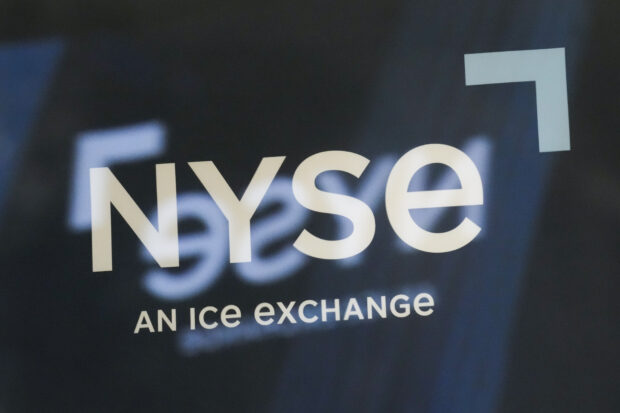
The NYSE logo is displayed on the floor at the New York Stock Exchange in New York, June 2, 2023. Stocks are drifting in early trading following a mixed set of profit reports as Wall Street’s momentum cools a bit. (AP Photo/Seth Wenig, file)
NEW YORK — Drops for Tesla, Netflix and other big tech-oriented stocks put the clamps on Wall Street’s torrid rally Thursday.
The S&P 500 fell 30.85, or 0.7 ,percent to 4,534.87, coming off its highest close since early April 2022 and its seventh gain in the last eight days. The Nasdaq composite dropped 294.71, or 2.1 percent, to 14,063.31 and its worst loss in more than four months.
The Dow Jones Industrial Average was an outlier and up 163.97 points, or 0.5 percent, to 35,225.18 because it has less of an emphasis on tech stocks.
Tesla tumbled 9.7 percent despite reporting stronger profit and revenue for the spring than expected. Analysts said investors may be concerned about how profitable the electric vehicle maker will be after cutting prices. Planned factory downtime during the summer for upgrades could also weigh on its upcoming results.
Because Tesla is one of the most valuable companies on Wall Street, its stock movements carry extra weight on the S&P 500 and other indexes.
Netflix sank 8.4 percent despite also reporting stronger profit than expected. One important measure for the company, how much revenue it makes from paid memberships on average, fell during the quarter from a year earlier.
Tesla and Netflix are two of the first huge tech-oriented companies to report their profits for the spring, and a lot is riding on the results. Big Tech stocks have rallied hard this year and been the primary reason for the S&P 500’s big gains. Netflix is still up 48 percent for the year so far, and Tesla has more than doubled.
If big tech stocks don’t produce the profits to justify the big moves, it could put the rally at jeopardy. Other huge winners from early this year also slid. Nvidia fell 3.3 percent, though it remains 211.5 percent higher for the year so far.
Across the rest of Wall Street, companies reported a mixed set of results.
Zions Bancorp. rose 10 percent after reporting stronger profit and revenue for the latest quarter than expected. It also said customers added $2 billion in deposits, or 3.2 percent, over the last three months, which it called a “solid’ number.
Truist Financial sank 7.1 percent after reporting weaker revenue than expected. It also said average deposits decreased 2.1 percent from earlier this year, though its profit topped expectations.
Banks have been under heavy scrutiny since three failed earlier this year, hurt by the heavy weight of high interest rates. They buckled when customers suddenly pulled their deposits, all at once.
The biggest loss in the S&P 500 came from Discover Financial, which slid 15.9 percent. Its results for the latest quarter fell short of forecasts, and it disclosed it was working with regulators to resolve an accounting error dating back to 2007 that misclassified some credit card accounts. It also said it was pausing buybacks of its stock while it conducts an internal review.
Doing the most work to limit the S&P 500’s losses was Johnson & Johnson. It rose 6.1 percent after reporting profit and revenue that both topped expectations for the latest quarter. It also raised forecasts for financial results for the full year.
Johnson & Johnson’s rally was the main reason the Dow was able to rise for a ninth straight day.
In the bond market, yields climbed after a report suggested the job market remains remarkably solid. Fewer workers applied for unemployment benefits last week than expected, an indication that layoffs aren’t worsening.
The strong job market has helped U.S. households continue spending despite much higher interest rates meant to bring down inflation, and that has helped keep the economy out of a long-predicted recession.
Inflation has been on the way down since last summer, which has many traders hoping the Federal Reserve’s next hike to interest rates, expected next week, will be the last of this cycle. That has many investors betting on what earlier looked like a long-odds result: The economy can outlast high inflation, and upcoming, easier interest rates will allow economic growth and corporate profits to keep rising.
But after Wall Street’s big rally this year, some professionals are cautioning investors not to get carried away.
The economy continues to face changes from still-high inflation and interest rates, with cuts to rates unlikely before March, according to Gregory Daco, chief economist at EY. He also pointed to possible strikes by unions and repayments on student loans as some of the vulnerabilities that could dent the economy. That’s leading to what he calls “nuanced optimism and realism.”
The yield on the 10-year Treasury rose to 3.85 percent from 3.75 percent late Wednesday. It helps set rates for mortgages and other important loans.
The two-year Treasury yield, which moves more on expectations for the Fed, climbed to 4.85 percent from 4.77 percent.
In markets abroad, stocks were higher across much of Europe and lower across much of Asia.